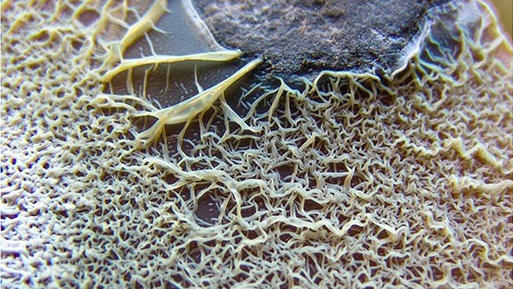Streptomyces: bacterial explorers
Posted on February 2, 2017 by Benjamin Thompson
Streptomyces bacteria are some of the most studied microbes on the planet. This genus of soil-dwelling organisms is best known for being prolific producers of many of the antibiotics that we use clinically. However, despite 70 years of study, they still have secrets left to discover.

Researchers from McMaster University in Canada have identified a new kind of growth that occurs in some species of Streptomyces, which enables colonies to quickly explore new areas and climb over tiny rocks, a feat proportional to a human climbing Everest. The group published their findings last month in the journal eLife.
The discovery began when PhD student Stephanie Jones – the lead author on the paper – showed a petri dish inoculated with a single colony of Streptomyces venezuelae to her supervisor Dr Marie Elliot. Normally, S. venezuelae colonies are dome shaped and a few millimetres in diameter. This one was rather different.
“The bacteria basically covered the entire petri dish,” Marie explains. “Streptomyces is something we thought of as a stationary organism – like a plant rooted into the ground – and suddenly here it is walking across a plate.”
The majority of Streptomyces species have a well-defined life cycle. When a bacterial spore germinates in the soil, it first grows out laterally to search for food, using a network of branching, finger-like projections known as ‘substrate mycelia’. When food is scarce, the growth pattern changes, with the colony sending up vertical ‘aerial mycelia’, topped with new spores that are spread by water droplets to other locations.
The team found that this new form of growth was caused by previously unseen “explorer cells”, which also grow laterally, but in a non-branching way and very rapidly – travelling about 10 times quicker than regular substrate mycelia.
Leading edge of S. venezuelae explorer cells over a 17 hr time course.
These explorers were first seen when an S. venezuelae colony was grown directly adjacent to a yeast colony. Later research showed it wasn’t the yeast specifically that caused the exploratory growth, but rather that the yeast had depleted the available glucose in the growth media.
On paper, explorer cell growth looks like a classic survival mechanism for a colony in trouble – when nutrient levels get low, S. venezuelae sends out scouts that move quickly to look for better food reserves in other areas. The explorer cells take obstacles in their stride; when the team challenged them with rocks and polystyrene walls, the cells just grew over them.
Later work showed the phenomenon could be switched on by growing the bacterium on glucose-free growth media. Levels of other nutrients seem to be important too, the details of which are being worked out.
Further investigation showed the system is a bit more complicated still. When the explorer cells start out on their expedition, the Streptomyces colony also releases a volatile compound called TMA. This molecule has several functions: it raises the pH of the surrounding environment; it’s toxic to other organisms; and it promotes explorer cell growth in other Streptomyces colonies nearby.
The first two functions make sense, as both help prevent the growth of competitor species, giving the explorer cells a head start. The third however is a bit of a mystery. When access to nutrients is everything, why help others? Why not take the biggest lead you can?
There are lots of other questions too: how do the explorer cells move so quickly? Why can’t all Streptomyces species grow in this manner? Why waste energy growing explorer cells when the colonies already produce spores in times of famine?
Marie and her group are currently looking to answer these questions and understand how bacteria ‘talk’ to each other in this system.
“We’re starting to tease apart the language used and identify the molecules that stimulate [exploratory] movement,” she says.
“We’re also trying to explore the translational aspects of this work. Could we get Streptomyces to grow over seeds or roots, to provide built-in antibiotic protection against pathogens, for instance?”
The work has opened up a new area of Streptomyces research. Even after 70 years, it looks like they can still throw up a few surprises.
